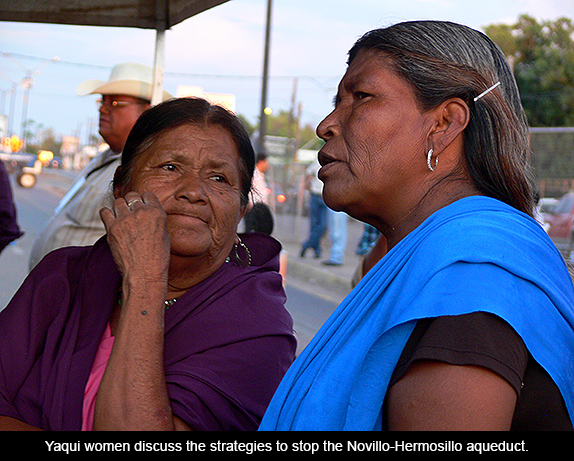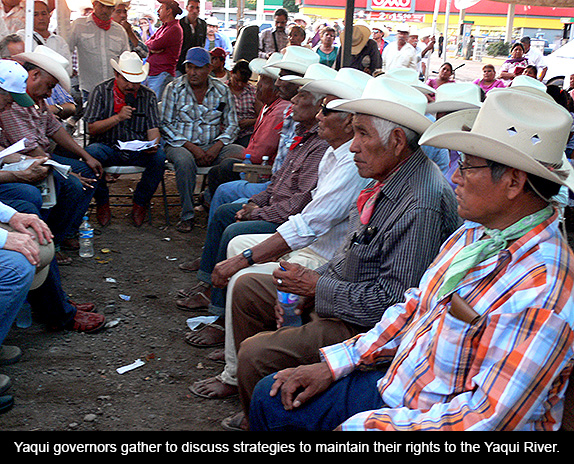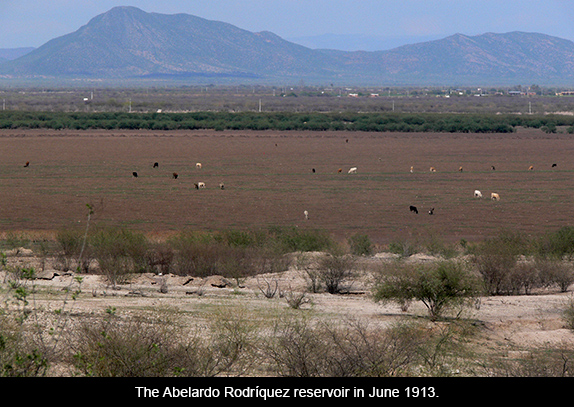Sonora Water Wars, Part 3
“El Nuevo Sonora” ContinuesSonora’s Hydraulic Traditions
October 08, 2014
(First published in New Mexico Mercury at: http://newmexicomercury.com/blog/comments/sonora_water_wars_part_3_el_nuevo_sonora_continues_sonoras_hydraulic_tradit#_ednref1 )
By Tom Barry

When you cross into Sonora from Arizona, you leave one hydraulic society and enter another. Both states are at risk. Their medium-term water futures are uncertain.
The water megaprojects – dams, reservoirs, aqueducts, and cement irrigation canals – that have made Sonoran Desert bloom with farms and cities are no longer sufficient. As temperatures rise, evaporation takes its toll, and droughts persist, there is an alarming shortfall -- between the water that people and business demand and the water that can be found.
Since the 1930s, Arizona and Sonora have confidently kept expanding their desert societies with the conviction that water would always follow money. Which proved to be true on both sides of the border. Federally funded dams and water-transfer projects transferred water from mountains and river valleys to some of the hottest and driest places in the transborder West, giving rise to such cities as Hermosillo, Guaymas, Ciudad Obregón, Tucson, Phoenix, and Las Vegas.
A mostly arid or semi-arid region that hosts North America’s four major deserts -- the Chihuahuan, Great Basin, Mojave, and Sonoran Desert – it is a transboundary region that has also been called the North American Southwest.[1]

When surface water proves insufficient, there’s always been groundwater to tap. First, diesel-fueled pumps penetrated deeper into the aquifers and bolsones, then as the federal governments in Mexico and the United States brought subsidized electricity to rural areas. Scores of well-drilling firms opened previously untapped reservoirs of fossil water.
Subsidized electricity prevailed throughout the transborder West. In Mexico, however, electricity costs for agribusiness have been especially negligible when calculating profit margins. Mexico’s agricultural sector benefits from the highest electricity subsidies for agriculture of all the Latin American and Caribbean nations.[2]
To drive nonstop on federal four-lane highways from northern Arizona through the nearly 400-mile length of Sonora takes about 12 hours. For those who might wonder (few people do) where the water comes from that makes the desert bloom with cities and monoculture agriculture, there are few readily discernible answers.
The water megaprojects that provide water to cities and farms are far away and out of sight. During the seven hours it takes to travel from the U.S.-Mexico border twin cities of Nogales to Sonora’s southern border with Sinaloa, you cross only dry rivers and arroyos.
In Sonora, like Arizona, water for the desert bloom comes from sparsely populated narrow river valleys and high mountains to the east and the north. Most residents of the desert cities never see the dams, reservoirs, and inter-basin aqueducts -- that have made their hydraulic societies possible. Ask someone in Phoenix or a tourist in the seaside resort of San Carlos on the Mar de Cortés where their water comes. Few know.
Hermosillo, the capital and most populous city of Sonora, is a good place for a field visit to consider the future of the transborder West. Situated a bit more than three hours south of Nogales, Hermosillo offers a clear but disturbing view of the past and the future of hydraulic societies in this transborder region.
Hermosillo also stands at the center of the most bitterly fought water wars of the desert West – a conflict that pits Hermosillo at the center of the state against the Yaquis and other water consumers of the Yaqui Valley in southern Sonora. Following the pattern of other regional water wars, the Yaqui water war is a complicated struggle involving urban and rural water users, the more and less powerful, and historically evolved special interests.
For those considering the water future of the transborder West, there are two must-see sites in Hermosillo. The first is the downtown headquarters of Sonora SI (Integrated System), which offers an up-beat scenario in which hydraulic megaprojects capture and redistribute scarce water resources.

Hermosillo Dam: First for Irrigation, Then Drinking, and Now Mostly Dry
Next, a short drive to the east takes you directly to Hermosillo’s very own water megaproject. Constructed in 1949 by the federal government, the Abelardo Rodríguez dam and reservoir were designed to capture Sonora River flows for use by Hermosillo.
At first, the federal government intended that all the water would be used by the rapidly expanding agribusinesses in the municipio (county) of Hermosillo -- which spans more than 14,885 sq. kilometers (5,745 sq. miles). A trip from Hermosillo’s center to the coastal town of Bahía Kino cuts through the vast coastal plains (known as the Costa de Hermosillo) of the Hermosillo municipio – a distance of 108 kilometers through arid scrublands converted to agribusiness by way of a labyrinth of irrigation canals and ditches.
In the 1980s, as the city of Hermosillo grew desperate for drinking water, the National Water Commission shifted the reservoir water from irrigation to domestic water consumption. But the onset of the drought in 1996-97 caused the reservoir to completely dry up, leaving the city once again without a dependable source of water.

Except in cases of heavy monsoon rains, the reservoir is usually a dusty bowl. When the city in 1998 gave up on the reservoir as a dependable source of drinking water, the old plans to transfer water to the city from the Yaqui River were resurrected. Yet it wasn’t until Sonora SI built the aqueduct in 2011-2012 that water from the Yaqui River began flowing to Hermosillo.
Surging fountains that rise outside Sonora SI building tell a story of a future made possible by hydraulic technology and infrastructure, with plenty of water for everyone – expanding desert cities, new agroexport industries, and a booming mining sector.
Can a new network of hydraulic megaprojects – including Sonora SI’s highly controversial Novillo-Hermosillo aqueduct -- keep Hermosillo growing and solve the state’s multitude of water crises and water wars? Governor Guillermo Padrés Elías, who launched Sonora SI in 2010 as part of his “El Nuevo Sonora” political platform, believes new dams and aqueducts will do the trick. The Yaquis and the Movimiento Ciudadano para el Agua in the Yaqui Valley think differently, as do the Guajirío indigenous settlements that will be displaced by the dam that Sonora SI is constructing across the Mayo River in southeastern Sonora.
[1] William deBuys, A Great Aridness, Oxford University Press, 2011.
[2] Banco Mundial, Los Recursos Naturales en América Latina y el Caribe, 2010, at: http://siteresources.worldbank.org/INTLAC/Resources/257803-1284336216058/Reporte.pdf
No comments:
Post a Comment